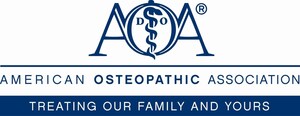Top Five Warning Signs of Internet Pornography Addiction
Teen Boys at Most Risk: What Parents Need to Know
SEATTLE, Oct. 28, 2014 /PRNewswire-USNewswire/ -- With Internet usage skyrocketing to three billion users worldwide this year—nearly 40% of the world population from 1% in 1995—mental health professionals are struggling with an issue that has risen just as quickly: Internet pornography addiction, one of the most common addictions today.
Sister Marysia Weber, DO, an osteopathic family physician certified by the American Board of Psychiatry and Neurology, is helping raise awareness of this growing problem and how to treat it at the American Osteopathic Association's OMED 2014, the Osteopathic Medical Conference & Exposition in Seattle.
"Internet pornography addiction can develop even more easily than a drug or alcohol addiction because it engages the most sensitive sense we have, our eyes; and it's readily available in unlimited quantities. It's even more addictive than drug addictions because the images are directly stored in the memory and imagination which remain long after viewing Internet pornography, altering the structure and function of the brain," said Dr. Weber.
She also says it's the medium of the message that has a more significant role than the content in altering the functional connectivity of the brain—specifically that high speed Internet can rewire the pleasure center, especially when coupled with pornographic images.
Studies show that those who view Internet pornography for hours each week have decreased gray matter, a major component of central nervous system, than those who do not view it. This means there are fewer neurons and neuroconnectivity in the pleasure centers of the brain. This leaves the brain craving more, while making it harder for the same images to provide pleasure. Addicts then seek increasingly deviant sexual images depicting violence or children to satisfy their craving.
"Internet pornography leaves people wanting more and more, but they may not necessarily like what they see, which contributes to symptoms of anxiety and depression," Dr. Weber says. "Over time, your senses dull and it's harder to find pleasure in the images, or even in everyday life."
High speed Internet and the subject matter create a highly addictive combination. Every second, at least 28,000 people are watching pornography on the Internet, and at least 40 million U.S. adults admit to viewing Internet pornography daily. And, according to the National Coalition for the Protection of Children & Families, 2010, 47 % of U.S. families reported that pornography was a problem in their home.
The most at risk? Teenage boys, 12 to 17 years old. "Addictions typically happen with adults—we've never had a group addicted which is so young and growing in numbers," says Dr. Weber.
During the teenage years, brains are still developing. If a teenager views Internet pornography, it can deform the pleasure centers of their brain, making it much more difficult to recover than older males who didn't grow up with the Internet. Dr. Weber says she sees teens and adults with erectile dysfunction because of Internet pornography, but that ED medications don't help, because they treat the organ, not the brain, where the problem lies.
Having an Internet pornography addiction so young also has serious implications for society as a whole. "Boys show more interest in deviant and illegal pornography and are more likely to act out than older adults," says Dr. Weber. She also warns that such an addiction can have a powerful and negative effect on families and marriages, with the addict not being able to show emotion with physical affection, including sex, and the addict is much more likely to be unfaithful to their spouse.
As Internet pornography uses more disturbing images to keep addicts viewing. Dr. Weber says the FBI is noticing an increase in violent sex crimes and child pornography, as well as sex trafficking—now an estimated $32 billion industry worldwide. "There are more sex slaves today worldwide then there have been in the history of mankind," said Dr. Weber.
What are the warning signs of addiction?
Dr. Weber notes that there is currently no agreed upon official medical definition of Internet pornography addiction, but that there is much medical literature on the topic. She says that addicts may show ADHD symptoms, be anxious or suffer from impaired concentration. They often conceal their addiction from family and friends, and can't or are unable to stop.
She recommends asking the following questions if you want to approach a loved one about a possible addiction:
- Have you ever viewed Internet pornography? If so, when did you start viewing it?
- How often do you view it? For how long?
- Why do you view Internet pornography? This question helps Dr. Weber figure out the triggers for the addiction. Many times, people are sad, lonely, depressed, frustrated or even bored.
- When did you notice seeking more images for more arousal? If someone is seeking more images, more often, this is often a sign of desensitization that happens in the pleasure centers of the brain as someone becomes addicted.
- How long has it been since you last viewed Internet pornography? Dr. Weber says that a good rule of thumb is at least three months for someone not to be considered addicted.
What can parents do?
Parents need to have a relationship with their children that promotes open and honest communication, says Dr. Weber. Studies show that kids are influenced by their parents and what they teach them about sex. "We need to talk about the ill effects of Internet pornography with our children, and give them the tools to withstand peer pressure," she says. Her tips include:
- Be aware. Check the video games and websites your children are interacting with, and the images featured. More and more, violent or sexual images are creeping into what parents think are safe sites or games.
- Limit screen time. Parents should lead by example and limit screen time with computers, tablets and mobile devices for the entire family.
- Role play. Show your children how to set up personal boundaries with friends when encountering questionable situations, such as sharing sexual images via apps like Snapchat or texting.
- Explain consequences. Let your children know that once an image is sent over the Internet, it is not possible to take it back. In some states, teens caught sexting are now being charged as sex offenders for distributing or possessing child pornography, and some are even being sent to prison. Also, future employers and college admissions counselors may stumble upon postings when doing research on applicants.
Treating Addiction
The good news is that Internet pornography addiction is treatable, but it takes hard work and time, like any addiction. With help from a trained mental health professional, Dr. Weber says those who want to recover need to find a reason to be motivated, and then learn their triggers or temptations, and remove them. Mindset and hope has a lot to do with recovery—if you believe you can, you will, and if you fall down, get back up and don't give up.
"Recovering addicts need to set up road blocks to purify their memory and imagination. First, get rid of all pornography, limit your use of Internet to what pertains to work, school and/or family and seek treatment from a trained mental health professional who can evaluate if you need an antidepressant medication," she said.
Protective software that filters pornography can help, but Dr. Weber says they have their limits and can be circumvented. She also suggests getting an accountability partner—someone who doesn't make an addict feel bad for failing, but can probe as to why they went back and encourage them to get back on the road to wellness.
Dr. Weber works with patients to develop their "observing self" to learn to focus on the moment, instead of the past images, using the five senses. This helps to refocus attention away from the sexual craving, which will decrease in intensity over time, she said.
Internet pornography addiction can be as toxic to a brain as chemical dependency. Dr. Weber warns, "Parents, educators, health care professionals and mental health professionals need to aggressively address Internet pornography addiction now."
About the American Osteopathic Association
The American Osteopathic Association (AOA) proudly represents its professional family of more than 104,000 osteopathic physicians (DOs) and osteopathic medical students; promotes public health; encourages scientific research; serves as the primary certifying body for DOs; is the accrediting agency for osteopathic medical schools; and has federal authority to accredit hospitals and other health care facilities. More information on DOs/osteopathic medicine can be found at www.osteopathic.org.
SOURCE American Osteopathic Association
Related Links
WANT YOUR COMPANY'S NEWS FEATURED ON PRNEWSWIRE.COM?
Newsrooms &
Influencers
Digital Media
Outlets
Journalists
Opted In






Share this article